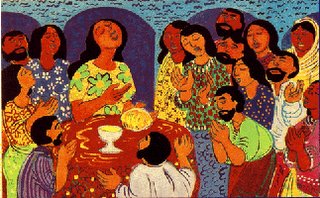by John Updike
Make no mistake: If he rose at all
it was as His body;
if the cells' dissolution did not reverse, the molecules
reknit, the amino acids rekindle,
the Church will fall.
It was not as the flowers,
each soft Spring recurrent;
it was not as his Spirit in the mouths and fuddled
eyes of his eleven apostles;
it was as His flesh: ours.
The same hinged thumbs and toes,
the same valved heart
that -- pierced -- died, withered, paused, and then
regathered out of enduring Might
new strength to enclose.
Let us not mock God with metaphor,
analogy, sidestepping, transcendence;
making of the event a parable, a sign painted in the
faded credulity of earlier ages:
let us walk through the door.
To be honest with you, I have a hard time "walking through the door" when it comes to the idea of the physical resurrection as described in today's text. Not a transition into some spiritualized realm; not mere physical resuscitation; rather, as those noted theologians of Monty Python would put it, "something completely different." If I think too hard about it I can come up with scores of reasons why this just doesn't make sense.
And I don't think I'm alone. Despite our weekly, or daily, affirmation of the creeds of the Church, I suspect that in our more honest moments most of us have a concept of Jesus' resurrection that's more akin to the spectral appearances of the dead on TV's Ghost Whisperer than to the scenes we read about in today's Gospel lesson.
But Luke is adamant, as he crafts his story, that this isn't the case with Jesus. The resurrected Jesus who appears to his friends is a Jesus you can get your hands on; a Jesus who can eat (as our guest preacher, the assistant to our synodical bishop, noted today, "a man after my own heart!"). This ain't no ghost. This ain't no hallucination. This Jesus is really real.
And maybe that's the crux of the matter: that it's hard for us to comprehend this because we have not yet been made real, as reality goes in the Reign of God.
There are parallels to this in our experience of our own human development. For instance -- are you the same person that you were at age 5, or 10, or 18, or 30? I know I'm not. I know there are times when I think back to the person I was even ten years ago, and it feels as if I'm remembering some other woman: Who was that? My physicality is not the same; my storehouse of knowledge, my set of life experiences, is not the same; my way of seeing, of understanding, is not the same. But yet, another level, I am the same. It's a paradox.
What Luke seems to be telling us, as he shares recollections of the risen Christ, is that Christ is leading us, his sisters and brothers, fellow members and heirs of the household of God, into another change. It's going to be a change so dramatic that it will even impact how we interface physically with the created world. Yet in other ways we'll be the same -- in Jesus' case, even down to the battle scars of his appointment with death.
At our church we have a weekly interlude in the service called "The Bag," where volunteers (and sometimes the volunteered) from the congregation share their lives with the rest of us, bringing with them a grocery bag containing three objects that have a special meaning for them. Today one of our parishoners -- someone who has experienced a lot of physical and other hardship in her life -- brought a string of pearls that her husband, a former soldier, had sent her during a tour of duty; at the time he'd narrowly escaped being injured in a bombing, so the gift was especially precious. The woman described how pearls are made; that irritating grains of sand inside mollusks' shells are gradually covered in layers of beautiful mother-of-pearl. She noted, "Maybe we're like pearls. Maybe it's all the struggle and pain that makes us who we are in the end."
Maybe the physical resurrection that we affirm even as we struggle to understand is that final point in our journey of life in Christ; a journey creating changes in us of which we're only dimly aware, until we meet Christ face to face and discover that we, like he, have been changed; like The Velveteen Rabbit, finally made real in a way that we can't imagine; like a pearl, formed into something new and beautiful.
"The Resurrection," S. Raj













